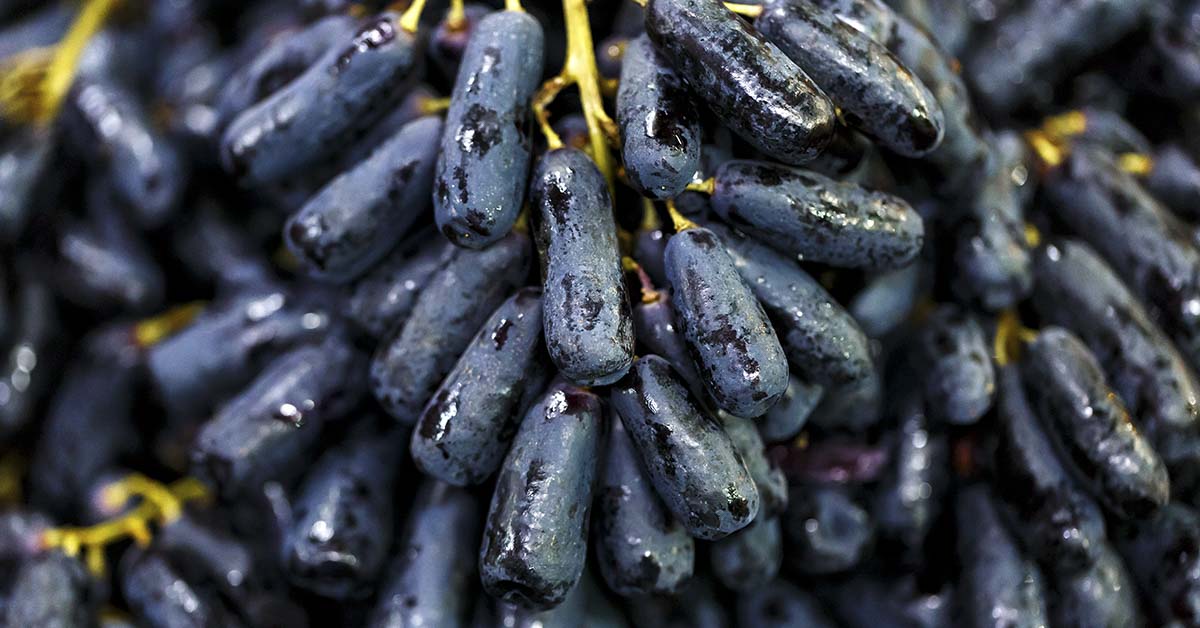When talking about grapes, most people think of the standard green or red variety, maybe even black. But there are many types of grapes, with different colors, flavors, shapes, and health benefits. Moon Drop grapes stand out because of their elongated shape and almost black skin. Unlike most grapes, these were invented in 2004 by International Fruit Genetics (IFG), an organization founded by Dr. David Cain in 2000. The grapes came about through agricultural experimentation (but without any kind of genetic modification.) They are an example of what nature can produce when nudged in the right direction.
What are Moon Drop Grapes?
Moon Drop grapes were originally called IFG Six while they were under development by International Fruit Genetics. They were created through a process called “embryo rescue”. It involves growing seed embryos in a cultured medium, similar to how seedless grapes are grown. Then the seedlings are planted into regular soil and grown with the typical farming practices. The grapes have never been altered genetically; the unique color and shape are a natural result of the breeding process that crossed two grape varieties. [1]
IFG originally patented the grapes as Sweet Sapphires but the name Moon Drop grapes came from store labeling. Perhaps it came due to their slight similarity to a water drop. Some stores labeled them as teardrop grapes or witch’s fingers. They are also easily identified as “long grapes.” Unfortunately, they are only available a few weeks each year in the late summer through early fall. Only select retailers in Canada and the United States can grow this variety. They cannot be legally grown in home gardens until at least June 2031, according to the patent.
Moon Drop grapes tend to be sweeter with a more concentrated grape flavor than more common varieties like Concord. The vines are covered with plastic to shield the grapes from the rain, allowing them to keep growing for longer than typical grape varieties, which results in their richly sweet flavor. They are comparable to Cotton Candy grapes, which were also created by IFG after years of artificial hybridization. Also, Moon Drop grapes are seedless with a firmer texture than regular grapes, making them a crunchy snack that may appeal to people who struggle with eating foods with inconsistent textures. In fact, the grapes are so firm, they could be snapped in half. [2]
Read: The Benefits of Eating Eggs (Even Everyday)
Health Benefits of Grapes
Researchers have yet to analyze Moon Drop Grapes’ specific health benefits, but they likely contain nutritional properties of other black grape varieties. These include antioxidants, vitamin A, vitamin C, vitamin K, potassium, flavonoids, copper, and manganese. Vitamin C, for example, can help the immune system counter bacterial and viral infections. Among the many antioxidants found in grapes, resveratrol is the most noteworthy. It can help reduce inflammation and oxidative stress, which can potentially fight against heart disease, cancer, and brain diseases like dementia, according to early studies. Grapes can also aid heart health since they are low in sodium and high in potassium, and both traits contribute to balanced blood pressure. Potassium, as well as vitamin K, helps maintain strong bones. But grapes also contain melatonin, which can help with sleep, making these fruits a sweet and smart evening snack. [3]
Moon Drop grapes are usually eaten by themselves, but they can also be added to salads, fruit bowls, or fruit skewers. They can also be frozen for an icy treat or blended into smoothies. When roasted, they can top savory meat dishes, ice cream, or toast. The grapes’ flavor pairs well with nuts, cheese, meat, other fruits, and herbs like mint, fennel, and rosemary.
More Unique Types of Grapes
It might surprise some people that there are many types of grapes. California, the largest grape-growing state in the United States, grows over 50 varieties. For instance, Crimson Seedless is the name of the typical red grapes in grocery stores. The typical green grapes are called Sultana or Thompson Seedless. Then there are Concord grapes, which are blue-purple and commonly eaten in juices, jams, and pies, although they are also enjoyed fresh.
Cotton Candy grapes are also products of IFG’s cross-breeding, and their sweet flavor is reminiscent of their namesake. They are slightly higher in sugar than Concord grapes, but they are easily a healthier choice than traditional cotton candy with the nutritional content of vitamins, fiber, and potassium. Red Globe grapes are known for their large size, round shape, rosy color, and subtly sweet flavor, making them ideal for snacking or freezing and using as ice cubes.
Glenora is a seedless grape that grows in large clusters, with each grape blue-black in color and medium in size. Their unique flavor is often called sweet with mildly spicy undertones. They are also disease resistant and easy to grow, so they are popular among farmers and home gardeners for those looking to grow black grapes before Moon Drop grapes’ patent ends. [4]
Keep Reading: You Should Never Rinse Your Turkey Before You Roast It
Sources
- “What Are Moon Drop Grapes?” Southern Living. Tadhg Hylier Stevens. December 12, 2022
- “Moon Drop Grapes.” Speciality Produce.
- “10 Health Benefits of Grapes.” Cleveland Clinic. November 15, 2021
- “16 Fascinating Types of Grapes.” Healthline. Jillian Kubala, MD, RD. January 2, 2020

